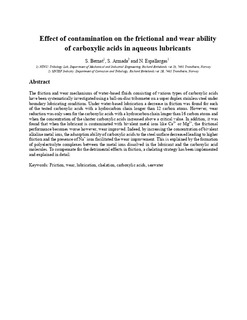Effect of Contamination on the Friction and Wear of Carboxylic Acids in Aqueous Lubricants
Journal article, Peer reviewed
Accepted version

Åpne
Permanent lenke
http://hdl.handle.net/11250/2595948Utgivelsesdato
2018Metadata
Vis full innførselSamlinger
Sammendrag
The friction and wear mechanisms of water-based fluids consisting of various types of carboxylic acids have been systematically investigated using a ball-on-disc tribometer on a super duplex stainless steel under boundary lubricating conditions. Under water-based lubrication, a decrease in friction was found for each of the tested carboxylic acids with a hydrocarbon chain longer than 12 carbon atoms. However, wear reduction was only seen for the carboxylic acids with a hydrocarbon chain longer than 16 carbon atoms or with shorter chain carboxylic acids in concentrations above a critical value. In addition, it was found that when the lubricant is contaminated with bivalent metal ions like Ca2+ or Mg2+, the frictional performance worsened; however, wear improved. Increasing the concentration of bivalent alkaline metal ions reduced the adsorption ability of carboxylic acids to the steel surface leading to higher friction and the presence of Na+ ions facilitated the wear improvement. This is explained by the formation of polyelectrolyte complexes between the metal ions dissolved in the lubricant and the carboxylic acid molecules. To compensate for the detrimental effects in friction, a chelating strategy has been implemented and explained in detail.